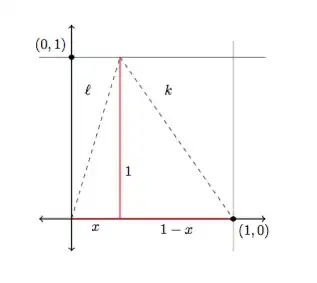Does exist a triangle with sides a integer length where one of height is equal to the side which is the base?
$a,k,l$ -natural, $a$ is lenght of hight
Does exist a triangle with sides a integer length where one of height is equal to the side which is the base?
$a,k,l$ -natural, $a$ is lenght of hight
In formulas, we want to find positive integers $a,b,c,d$ solving the Diophantine equations $$ a^2+(a+b)^2=c^2 $$
$$ b^2+(a+b)^2=d^2. $$ In particular, we obtain the Diophantine equation $$ a^2+d^2=b^2+c^2, $$ which has been studied [here]( Diophantine equation $a^2+b^2=c^2+d^2$). hence there are integers $p,q,r,s$ such that $$ (a,b,c,d)=(pr+qs,ps+qr,pr-qs,qr-ps). $$ Use this to show that there are no solutions (if I am not wrong); the equations then are given by $$ (2pr + ps + qr)(ps + qr + 2qs) + (pr + qs)^2=0, $$
$$ (pr + 2ps + qs)(pr + 2qr + qs) + (ps + qr)^2=0. $$
[Note: This is probably the same as what Dietrich said, only I like to see the geometry.]
The question is equivalent to asking if there is a triangle with rational side lengths, since we can just scale by the product of the denominators and get integers. So we can assume that $a=1$, since we can just scale by the inverse of whatever rational number $a$ is.
Geometrically, this allows us to put our triangle in the $1\times 1$ square in the cooridinate plane. This now only works for triangles with the third vertex between (0,1) and (1,1). I suppose we would need to modify this to use the law of cosines for the rest of the triangles. 
Then it is just the pythagorean theorme and we have that $$\ell^2 =x^2+1$$ and $$k^2=(1-x)^2+1. $$
We want $k$ and $\ell$ to be rational, so lets just call $\ell=\frac{p}{q}$. Then $$x^2=\frac{p^2}{q^2}-1= \frac{p^2-q^2}{q^2},$$ thus $$x= \frac{\sqrt{p^2-q^2}}{q}.$$
So with some replacement and simplification, $$k^2=2-2x+x^2$$ $$k^2=2-2\frac{\sqrt{p^2-q^2}}{q}+\frac{p^2-q^2}{q^2}$$ $$k^2=\frac{2q^2}{q^2}-\frac{2q\sqrt{p^2-q^2}}{q^2}+\frac{p^2-q^2}{q^2}$$ $$k^2=\frac{q^2-2q\sqrt{p^2-q^2}+p^2}{q^2}$$ $$k=\frac{\sqrt{q^2+p^2-2q\sqrt{p^2-q^2}}}{q}$$
Then all we need is that the numerator is an integer. I am in the process of making mathematica find one, but I checked the first $1000\times 1000$ pairs of integers for $p<q$ and came up with nothing... Will let you know if I find something though.
Thanks to TonyK for finding a mistake of mine.